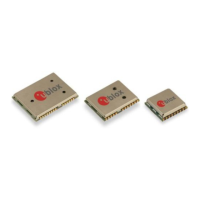LEA-6 / NEO-6 / MAX-6 - Hardware Integration Manual
UBX-14054794 Production Information Hardware description
Page 16 of 85
1.7 I/O pins
1.7.1 RESET_N
LEA-6 modules include a RESET_N pin. Driving RESET_N low activates a hardware reset of the system. RESET_N
is only an input and will not reset external circuitry.
Use components with open drain output (i.e. with buffer or voltage supervisor).
There is an internal pull up resistor of 3.3 k to VCC inside the module that requires that the reset circuitry can
deliver enough current (e.g. 1 mA).
Do not drive RESET_N high.
NEO-6 and MAX-6 modules do not include a RESET_N pin. However, this functionality can be implemented for
these modules by connecting the NEO-6 and MAX-6 pin 8 to pin 9 with a 3.3 k resistor, instead of connecting
them directly. Pin 8 (NEO-6) or pin 9 (MAX-6) can then be used as a RESET_N input with the same
characteristics as the reset pin on LEA-6 modules.
Use caution when implementing RESET_N on NEO-6 and MAX-6 modules since forward
compatibility is not guaranteed.
1.7.2 EXTINT - External interrupt pin
EXTINT0 is an external interrupt pin with fixed input voltage thresholds with respect to VCC (see the data sheet
for more information). It can be used for the time mark function on LEA-6T or for wake-up functions in Power
Save Mode on all u-blox 6 LCC modules. Leave open if unused.
1.7.3 AADET_N (LEA-6)
AADET_N is an input pin and is used to report whether an external circuit has detected an external antenna or
not. Low means the antenna has been detected. High means no external antenna has been detected.
See section 2.6.4 for an implementation example.
1.7.4 Configuration pins (LEA-6S/6A, NEO-6)
ROM-based modules provide up to 3 pins (CFG_COM0, CFG_COM1, and CFG_GPS0) for boot-time
configuration. These become effective immediately after start-up. Once the module has started, the
configuration settings can be modified with UBX configuration messages. The modified settings remain effective
until power-down or reset. If these settings have been stored in battery-backup RAM, then the modified
configuration will be retained, as long as the backup battery supply is not interrupted.
The module data sheets indicate the meaning of the configuration pins when they are high (1) or low (0). In fact
no configuration pins need to be pulled high. All have internal pull ups and therefore default to the high (1)
state when left open or connected to a high impedance output. They should be left open unless there is a need
to pull them low to alter the initial configuration.
Some configuration pins are shared with other functions. During start-up, the module reads the state of the
configuration pins. Afterwards the other functions can be used.
The configuration pins of u-blox 6 use an internal pull-up resistor, which determines the default setting.
For more information about settings and messages see the module data sheet.
MAX-6 doesn’t have pins for boot-time configuration.
1.7.5 Second time pulse for LEA-6T-0 and LEA-6T-1
LEA-6T-0 and LEA-6T-1 include a second time pulse pin (TIMEPULSE2). For more information and configuration
see the LEA-6 Data Sheet [1] and also the u-blox 6 Receiver Description including Protocol Specification [4]. (LEA-
6T-2 provides a single time pulse output only.)

